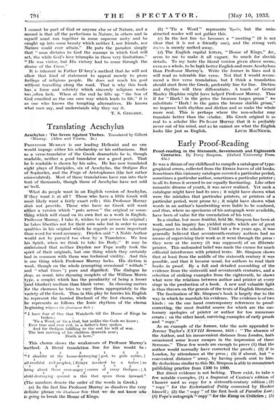Early Proof-Reading
IT was a dream of my childhood to compile a catalogue of typo- graphical errors, collected from the Errata leaves of old books. Sometimes this.visionary catalogue covered a particular peribd, sometimes a particular author, sometimes a particular printer ; in all its forms it seemed to me equally fascinating. Like other romantic dreams of youth, it was never realized. Yet such a catalogue might have had its uses ; it might have shown what were the mistakes that particular printers, or printers of a particular period, were prone to ; it might have shown what words in an author's handwriting were liable to be confused, and thus, where no specimens of his autograph were available, have been of Value for the emendation of his text.
In a similar, but more fruitful, field Mr. Simpson has been at work, and his inquiry has yielded results which are of great importance to the scholar. Until but a few, years ago, it 'Was generally believed that seventeenth-century authors had no means of supervising their work as-it went through the press : they were at the mercy (it was supposed)-. of an illiterate printer. This unfounded belief was Made the excuse for much editorial interference with printed texts. Mr. Simpson shows that at least from the middle of the sixteenth .century it was possible, and that it became usual, for authors to read their books in proof. By a full and detailed assembling of the evidence from the sixteenth andSeventeenth centuries, and a selection of striking examples from the eighteenth, he shows what were the relations between author and printer at every stage in the production of a book. A new and valuable light is thus thrown on the genesis of the texts of English literature.
The-fascination of 'Mr. Simpson's book is largely due to the way in which he marshals his evidence. The evidence is of two kinds : on the one hand contemporary references to proof- correcting, the most fruitful source for which are the cus- tomary apologies of printer or author for too numerous
-errata ; on the other hand, surviving examples of early proofs . and "copy."
. As an example of the former, take the note appended to Jeremy' Taylor's. XXVIII Sermons, 1651: "The absenbe of the Author, and his inconvenient distance from London, bath occasioned some lesser escapes in the impression of these Sermons." These few words are enough to prove (1) that the author would normally have corrected the proofs ; (2) if in London, by attendance at the press ; (3) if absent, but "a convenient distance" away, by having proofs sent to him. By deductions similar to this Mr. Simpson is able to reconstruct publishing practice from 1500 to 1800.
But direct evidence is not lacking. There exist, to take a few notable- examples, (1)- a fragment of Caxton's edition of Chaucer used as copy for a sixteenth-century edition ; (2) " copy " for the Eccksiastical Polity corrected by Hooker himself; the_." copy." .of the. first book _of Paradise Lost ; (4)-- PoPeistiutogriPh -b-•=copf":ft* the Earsiji on Oriticari: ; (5)
a page of the proofs of the First Folio of Shakespeare ; (6) all the first proofs of Boswell's Johnson.
Mr. Simpson discusses these together with many other similar pieces of evidence collected in the course of his wide and deep researches, and describes the customs of the printing house from contemporary records, the fullest of which is supplied by the Oxford Press. That Press has printed his own book beautifully and illustrated it with seventeen plates re- producing early examples of proofs and copy. The book itself affords, both in its subject and in its method, striking evidence of the revolution that has come about in English scholarship during the last twenty years.
JOIIN SPARROW.



































































 Previous page
Previous page